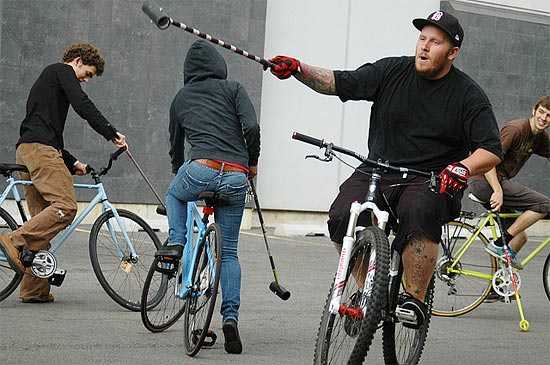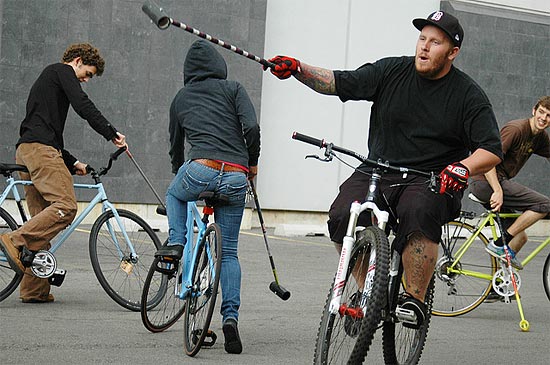 Bike polo in Provo, Utah.Photo: Elly BlueElly Blue is on a monthlong Dinner & Bikes tour around the western U.S., along with Portland bike filmmaker Joe Biel and traveling vegan chef Joshua Ploeg. This is one of her thrice-weekly dispatches from the road about bicycle culture and economy. Read them all here.
Bike polo in Provo, Utah.Photo: Elly BlueElly Blue is on a monthlong Dinner & Bikes tour around the western U.S., along with Portland bike filmmaker Joe Biel and traveling vegan chef Joshua Ploeg. This is one of her thrice-weekly dispatches from the road about bicycle culture and economy. Read them all here.
Provo, Utah: As is the case at most bike polo matches, the sidelines at this game in a bank parking lot are marked by clusters of cans and bottles. But in this town, where dozens of players and spectators meet two or three times a week, they’re not half-empty vessels of cheap beer; it’s root beer.
The youngest player, age 3, swings a miniature mallet decorated with stickers that proclaim “God loves me.” She expertly thwacks a tennis ball right between the hot pink wheels of her pedal-less Strider bike and then has to be prevented from chasing it onto the court.
Nestled at the base of the Wasatch Mountains, Provo is home to the widest streets and some of the worst air pollution in the nation. It’s the most politically conservative large city in the U.S., and 88 percent of its residents are members of the LDS church. Provo wouldn’t be any outsider’s first guess for an up-and-coming bicycle city.
But, as we discovered on a recent stop on our Dinner & Bikes tour, bikes are booming here. The city boasts a huge increase in ridership in the last few years, local businesses that are eager to embrace the transportation boom, a friendly city government that sees the sense in striping bike lanes, energetic and effective advocates, a thriving bicycle culture that seems to easily cross party lines and social divisions — and, since early this summer, a thriving polo scene.
It all seems too good to be true. What’s the catch? I turn away from the polo game and grill our host, Zac Whitmore, the young polo player’s dad. He works at a local bike shop and is one of the founders of the city’s bike advocacy group, the Provo Bicycle Committee.
“There are two obstacles,” he says. “One is weather. But that’s just perception, right?” This is a huge outdoor sports town, he explains, so everyone already has all the gear they need to ride through the winter.
The other impediment? “Infrastructure.” As in, they can’t seem to build it fast enough. Our hosts bemoan Provo’s lack of green lanes, bike boxes, and other infrastructure doodads that exist in great abundance in nearby Salt Lake City. “We don’t even have sharrows yet!” says Krysta Whitmore, Zac’s wife.
But all of these symbols of bike-friendliness are on the near horizon. The city has contracted with a company to write it a bike master plan. In the meantime, bike lanes have been going in with very little of the usual wrangling. It turns out that those extra-wide streets are an advantage: there’s plenty of room for everyone. Adding a bike lane is as simple as repainting the lines — paint and labor to redo one mile costs just $1,800 here, says Zac, while the national average is $5,000. “Pennies on the dollar, dude.”
Better than any amount of fancy infrastructure, though, Provo’s conditions are amazingly good for bicycling overall, including a grid of low-traffic streets, drivers who are almost cartoonishly polite, and a plethora of bike-friendly businesses.
It seems that this city in the heart of the Happy Valley, as Utahns know it, has simply never run aground on the big problem of bicycle transportation: politics. “Isn’t anyone against it?” I ask. Not really, Zac says. Even the city fathers just roll their eyes, like, “Okay, it’s the bike people again.”
When promoting bikes and bike infrastructure, Zac almost never mentions the environment. Instead, he pushes the economic case for bicycling, pretty much the same points I’m making on this tour — and made in my Bikenomics series for Grist.
Back at the Whitmores’ apartment that night, I’m perusing a wall full of bicycle-themed artwork and notice a hand-painted placard that reads “We fear the devil & love to pedal.”
“Is there a connection between bicycling and religion here?” I ask Zac.
“Yeah,” he says, “LDS missionaries ride bikes.”
“They don’t really think of them as religious,” says a family friend who’s dropped by to visit, panting after a long hilly ride.
“People don’t connect them,” Zac laughs. “But you have a lot of young men who have converting experiences to bicycles while on the mission. So we try to catch them when they come to BYU. We’re like, ‘Hey friend! Need some work?’ They’re used to passing out information and talking to people. It’s perfect.”
“OK,” I say, teasing him. “I’m going to write about how you have no problems here.”
“We have problems!” Krysta says.
“What are they?”
“Ummm….” Everyone laughs. “New people come in to the University and they don’t always know how to ride safely,” she says.
“But that’s an opportunity!” responds Zac.
I rest my case. Sit on the sidewalk in this town, and you can almost see the bicycle culture growing. Last week, a group of traffic engineers learned about the new bikeway guidelines from the National Association of City Transportation Officials; next week the city hosts its first ciclovia event, with Center Street opened up to biking and walking. In only a matter of days the first bike collective will open.
Winter’s coming, true, but Utahns are used to it. And the quickly growing cadre of polo enthusiasts has already found an underground parking garage, mysteriously unused, where they can carry on their thrice-weekly games.



